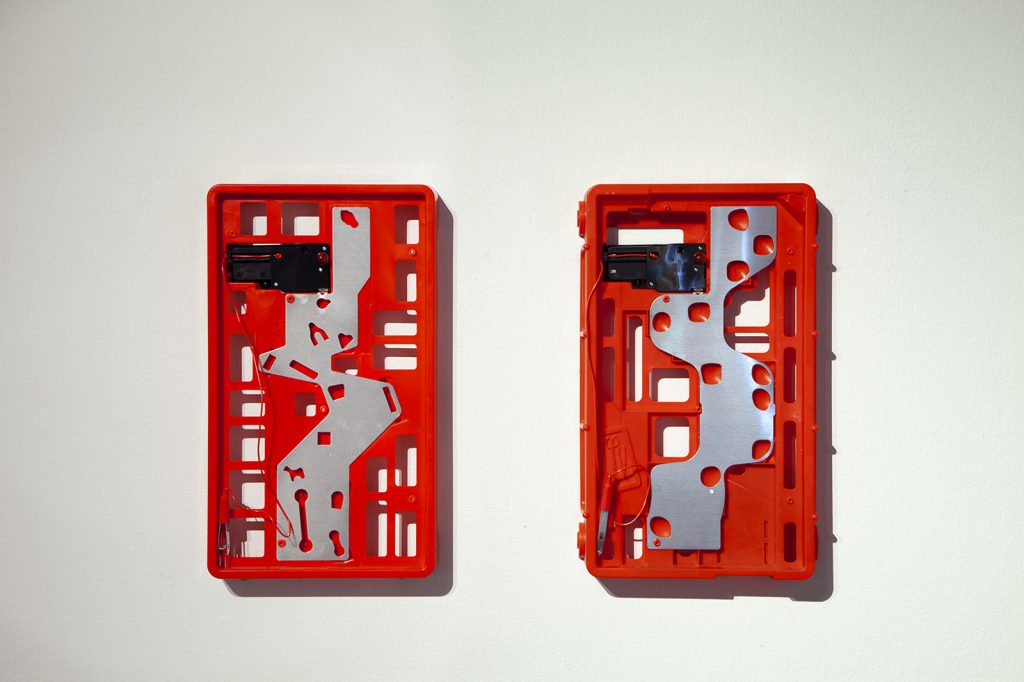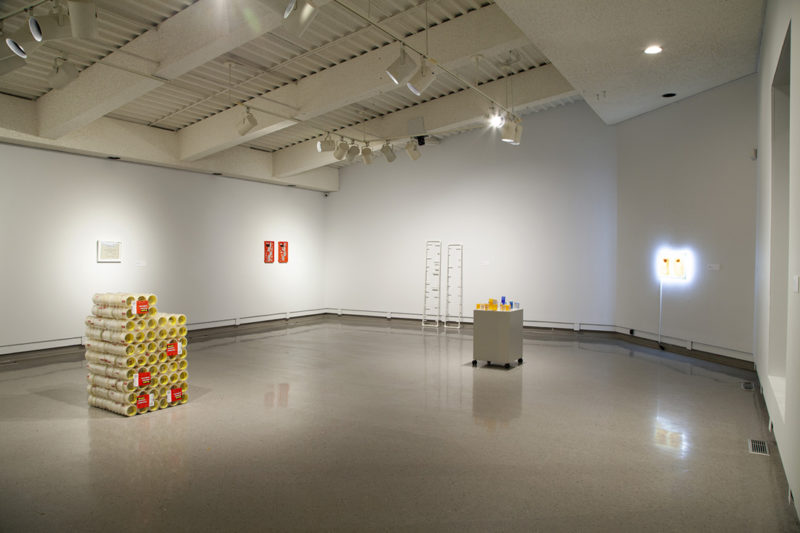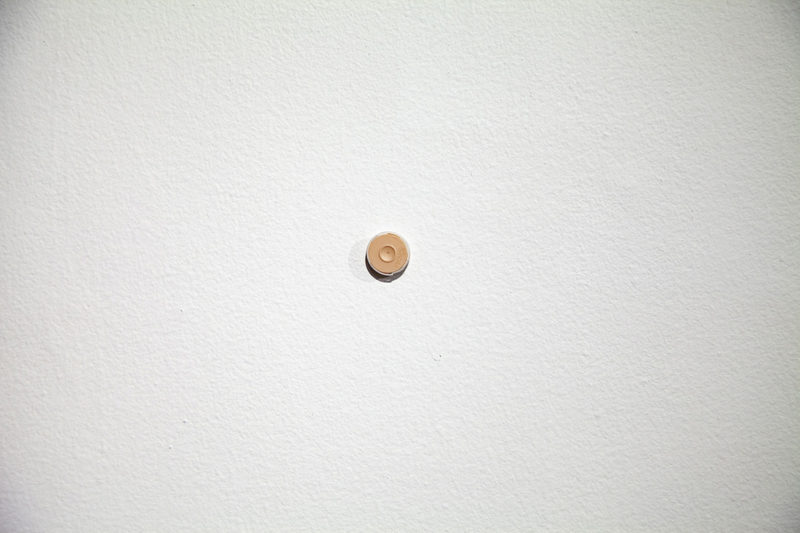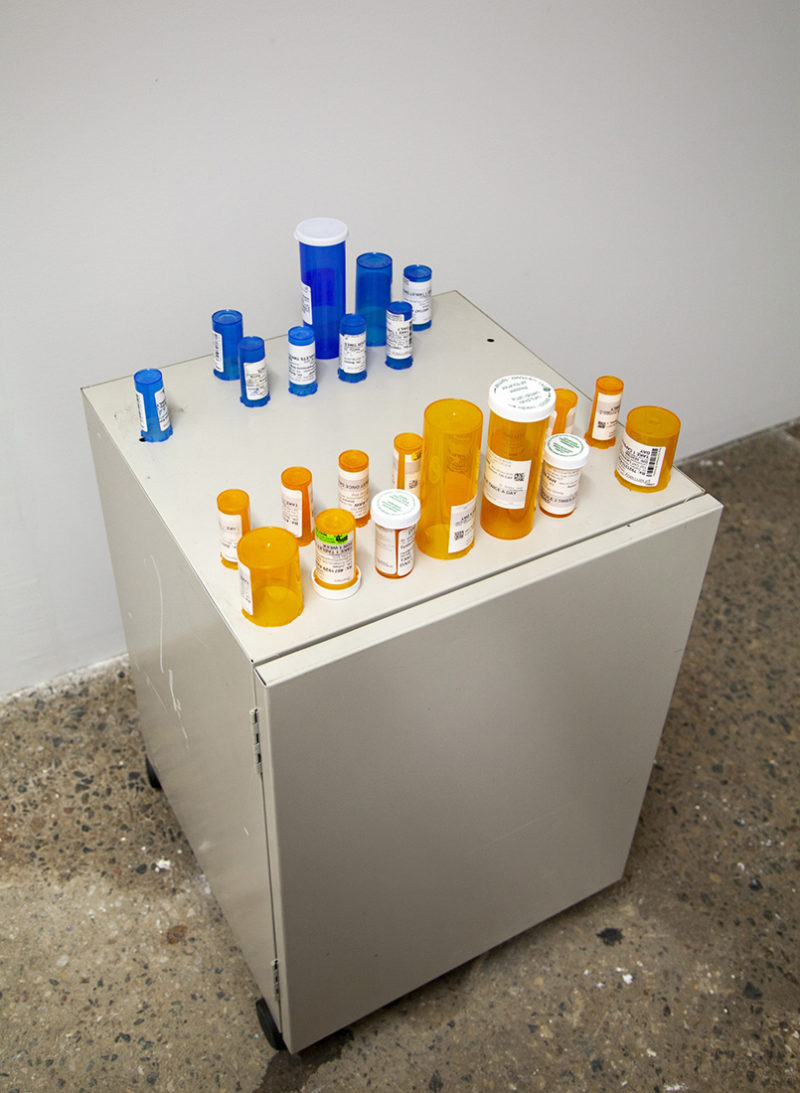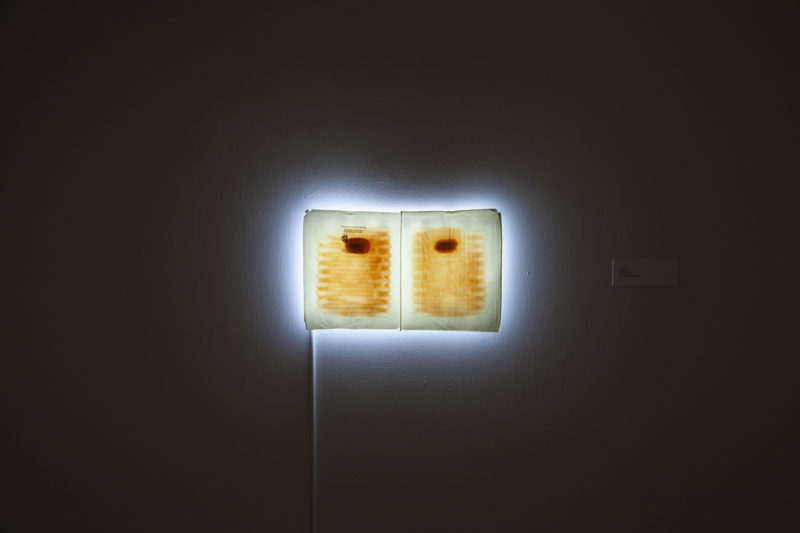The Sacred Particularities of Care: Julie Oh’s ‘Tunnel, Air, Mother’
26 November 2020
By Nic Wilson
A labyrinth is distinguished from a maze by its lack of dead ends and by its unicursal paths. The traveler is easily disoriented by the winding path, moving against their intuition and sense of direction. In the concentric circles and hairpin turns, the walker moves along a line that bends in on itself. Traditionally, one starts their walk on the outside of the labyrinth moving circuitously toward and away from the centre until they arrive, almost by surprise. Similarly, Julie Oh’s work moves with the turns of the labyrinth, but it starts at the centre. It takes you along in looping turns toward and away from the specificity of the heating blanket or the prescription bottle until this known thing is strange, known, strange, and known again. The work of the labyrinth is embodied work; it makes an internal world into physical space. Similarly, so is navigating Oh’s Tunnel, Air, Mother—a body of work that confounds, conflates and takes pleasure in the already messy binaries of mother-daughter, parent-child, caregiver and receiver, intimate and communal, personal and public. Rather than imagining a spectrum—a straight line—between fixed positions, the work in this show travels the curves and loops between them.
As my mother grows older, I think about the time in my life when she was not growing; the time when, to me, she was just my mother. Not growing, not changing. In the solipsism of childhood it’s easy to miss one’s parents being human animals. Throughout my teenage years, our family was concerned with the observation of my grandmother. As she grew into dementia, we remained cautiously vigilant of her actions, her eating, her speech, her improvised home improvement projects. There were always things that felt like slips. She put plastic trays in the oven, she called me by my uncle’s name, she confidently turned the wrong way down one-way streets she had traveled her entire life. But there were also days when we would find her up a ladder or hurling firewood down her staircase, just as she had done for years. It would have seemed easier if her mind always moved in one direction, but dementia is not like that. It makes the mind slippery, unfixed—for both the person experiencing it and those who care for them. As my mother grows older, the same vigilance has been reignited in my sister and me.
There are two iterations of the board game Operation on the wall, each opened up as if for a real surgical intervention. The bodies are fire engine red and a metal plate winds like a river through each of their centres. These metal pieces make matching meanders but the particular bends are smoothed and stretched from one generation to the other. They are labeled “contemporary” and “classic,” hinting at the generational leanings of Julie Oh’s exhibition Tunnel, Air, Mother at Dunlop Art Gallery in Regina, SK. Oh’s audaciously minimal work starts at the centre of an object, in its specificity and often its plainness.
Several hours before the opening, Oh mopped the floor of the small, suburban gallery. In the video document of this action, her pace is not slow, nor is it fast. Oh takes the pace of work itself, as though this is not a singular event but rather a link in a chain of habit. This action is not art-as-life or vice versa, and does not take the heightened posture of ‘performance’. The thing I often reflect upon in Oh’s work is the fact that it is just existing, which seems to be one of the most elusive attitudes for artwork to project. Not too cool or too aspirational, not nonchalant, not overly eager or withholding. Just existing. Similarly, the lighting and atmosphere of the gallery are not dimmed to make the space into a theatre for art works. There are no dramatic spots or pools of light that separate artworks into individual pieces. Though many of the works are partnered, there is a sense that you are entering a constellation of individuals; each piece is both connected to another specifically and each piece is connected to a whole.
The gallery has a window with two large vertical panes which Oh has covered with a reflective film, turning the window into a one-way mirror, and the entire gallery into an observation room. On the opposite wall, a voice prosthesis the size of a quarter is a small, lonely reminder of the third-party forces that knit themselves into our intimate relationships. This small button, used to replace vocal sounds that have been lost after the surgical removal of the voice box, is the result of a period of illness that Oh’s mother experienced, and it is displayed at the height that it would have sat on her body while in use, just above the suprasternal notch.
Though it can come at any age, the ‘medical gaze’ (1) is seemingly synonymous with aging. This gaze is the difference between looking at someone’s eye and looking into their eye. Often as people grow older they are pushed further and further from personhood and towards the status of a gooey sack of malfunctioning component parts. Much like Oh’s exploration of games, the body becomes a set of analytical problems, a field of experimentation or, most cruelly, a canvas for virtuosity. The professionalism, bureaucracy, and certification of medicine is obliquely referred to by Parenting Certificate (2019) which is a record of Oh’s mother completing a course called “Parent Effectiveness Training.”
It is hard for me to think about medical attention as ‘care’ when it exists in the realm of commodity and transaction. Capitalism is so deeply embedded in our lives that it’s close to impossible to think of any activity or service existing outside of a ‘profession’. I have been the recipient of medical attention that felt like genuine care, but also of the kind that felt like disdain or resentment for employment in general. While I lay mangled in a bed from a lethal car accident, two nurses cut off my clothes, brought me warm blankets, and inserted a catheter. One was kind and touched my forehead warmly with his gigantic hands, the other rolled his eyes when I lamented the destruction of my favourite shirt as it was hacked off my body. I know there is care in these spaces, but there is also the possibility of cruelty that far outstretches my comparatively humble example.
“Learning’s not a straight line!” I yell from the couch as my devoted boyfriend battles our defiant baby dog for a rawhide bone, pushing his back end toward the ground breathing “sit” over and over into the scruff of his rapidly expanding frame.
Each relationship of care has its own sacred particularities that often get squashed in language, and I wonder which of these particularities are lost in calling Paula my mother and myself her son. Whenever intimate relationships are committed to categories like parent, child, lover, or friend, one inevitably engages in a process of simultaneous abstraction and specification. Each person inevitably inhabits one or more of these roles and they are quite ubiquitous, but the way each person inhabits those roles and the ways that they layer and intersect can result in an infinite amount of specificity. Oh also plays on this spectrum between ubiquity and specificity and thinks in the murky depths between the alienation of consumer products, such as a pallet of packing tape, and the intimate offering of the piece Voice Box (a gift for my Mom) (2019). Oh told me that her mother uses tape as a fix-all. Anything that needs mending, needs fixing, needs care, gets a varying amount of tape. This monumental pile, which seems ready for dispersal from an end cap at Staples or Wal-Mart, becomes a huge chunk of care—gifted to a mother from a daughter.
Oh’s work makes me aware of the things that live inside of other things. When I look at the pill bottles that make up Chess (2019), I am looking into the object towards my own pill bottles, back to Oh’s mother’s pill bottles, toward my mother’s pill bottles. I think about what pulls people and things together and what defines them; what moves them from things that can be the same or different, to things that can be the same and different.
One of the reasons I am attracted to Oh’s work is because she engages with the question of intimacy in consumer products and found objects. The mass production and consumption of late-capitalism are often a convenient target for simplistic critique. Unchecked expansion of industry and endless production of cheap, disposable plastics is bad. It is destructive, suicidal, and oppressive, but Oh complicates this understanding by acknowledging that these objects also hold emotions, memories, relationships, and even surrogate selves. In the piece Lungs (2019) Oh presents the internal plastic lining of a burnt out heating pad as a lightbox. This now defunct object of comfort which is held against the body, which held her mother’s body, is opened up and tuned into a papery membrane streaked with orange and red lines. As I looked at this thin sheet of plastic, paired with a single word: “lungs”, I thought about holding my grandmother’s delicate hands, her translucent skin, her veins.
I’m now the same age as my parents were when they had my older sister. I have just become a caregiver to an explosive husky-dachshund puppy. He often vibrates with energy, or perhaps the terror of being newly alive. He jumps and barks. He pulls his claws across my arms, opening up small rivulets of blood that heal into long zipper-like scabs. With him, I have broached the horizon of parenting as far as I ever will, pulling bark and leaves from his mouth, saying “yuck” repeatedly before unfurling a bright pink plastic bag and picking up his shit which holds the warmth of his growing body.
Within Tunnel, Air, Mother, objects become multivalent; they are simultaneously possessions of a single person, artifacts of a relationship, metaphors for specific people, and also a record of the way those people fit into broader social roles. Through the tumbling and turning of ideas, objects, people, Oh has presented the messy route one might take in caring. In each turn of the labyrinth her position changes, from child to adult, which brings the concomitant shift in relationships with one’s body and the bodies which made that body.
- Michel Foucault, The Birth of the Clinic: an Archeology of Medical Perception, trans. A. M. Sheridan Smith (London: Routledge, 1991), 135.
Tunnel, Air, Mother ran from November 20, 2019 – January 26, 2020 at the Dunlop Art Gallery‘s Sherwood Gallery in Regina, SK.
Feature Image: Operation (Classic and Contemporary), 2019 by Julie Oh. Photo courtesy of the artist.

